เครื่องอัดเม็ดยา เป็นเครื่องจักรการผลิตที่สำคัญในกระบวนการขึ้นรูปยาแบบเม็ด ซึ่งใช้กันอย่างแพร่หลายในอุตสาหกรรมยาและเคมีภัณฑ์ ในฐานะผู้ผลิตเครื่องจักรยาและบรรจุภัณฑ์อันดับ 3 ของจีนในมณฑลกวางตุ้ง RichPacking ได้นำประสบการณ์อันยาวนานกว่า 31 ปี มาใช้เพื่อแนะนำเครื่องอัดยาเม็ดแบบครอบคลุมและเข้าใจง่ายในบทความนี้ เราหวังว่าบทความนี้จะช่วยให้คุณเข้าใจอุปกรณ์สำคัญนี้อย่างถ่องแท้
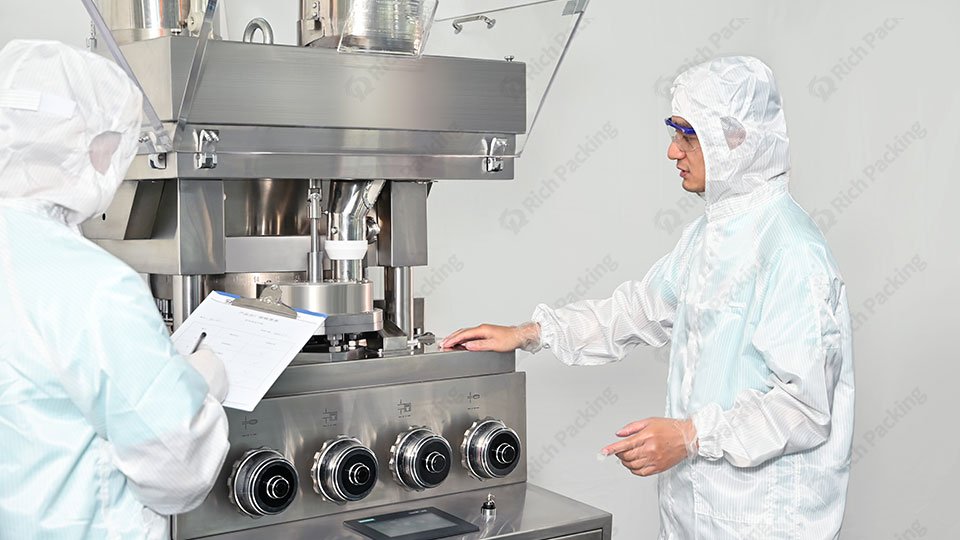
เครื่องอัดเม็ดยาเป็นอุปกรณ์ที่อัดผง เม็ดเล็ก เม็ดเล็ก หรือส่วนผสมต่างๆ ให้เป็นเม็ดยาที่มีขนาดเท่ากัน รูปทรงของเม็ดยาอาจเป็นทรงกลม เพชร แหวน หรือรูปทรงอื่นๆ ที่ไม่สม่ำเสมอ นอกจากนี้ เครื่องยังสามารถผลิตเม็ดยาหลายชั้น เช่น เม็ดยาสองสีสองชั้น และเม็ดยาสามสีสามชั้น
มาเจาะลึกหลักการทำงานของ เครื่องอัดเม็ดยา . สามารถสรุปได้สั้น ๆ เป็น 3 ขั้นตอน:
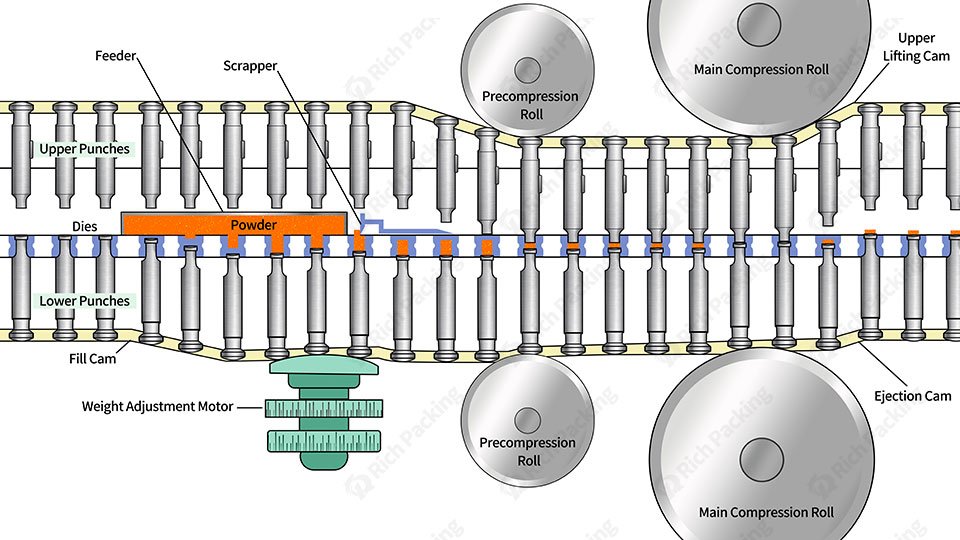
2. การบีบอัด :หัวปั๊มด้านบนและด้านล่างจะออกแรงกดผง เม็ด หรือส่วนผสมที่บรรจุในแม่พิมพ์ให้กลายเป็นเม็ด
3. การดีดออก :เมื่อเม็ดยาถูกบีบอัดแล้ว เม็ดยาจะถูกดีดออกจากแม่พิมพ์
จากที่กล่าวมาข้างต้น เราเข้าใจว่าหลักการพื้นฐานของเครื่องอัดเม็ดยาค่อนข้างเรียบง่าย จากการใช้งานที่แตกต่างกันของสามขั้นตอนการทำงาน เราจึงสามารถแบ่งประเภทหลักๆ ได้เป็น เครื่องอัดเม็ดยาแบบใช้มือ เครื่องอัดเม็ดยาแบบเจาะเดี่ยว เครื่องอัดเม็ดยาแบบเจาะตะกร้า และเครื่องอัดเม็ดยาแบบหมุน
แท่นอัดยาเม็ดแบบมือกดเป็นเครื่องมือที่ใช้แรงคนล้วนๆ ในการบีบอัดยาเม็ด วัตถุดิบจะถูกเติมลงไปด้วยมือ บีบอัดด้วยแรงคน และนำยาเม็ดที่เสร็จแล้วออกมาด้วยมือ นี่เป็นวิธีการพื้นฐานที่สุด
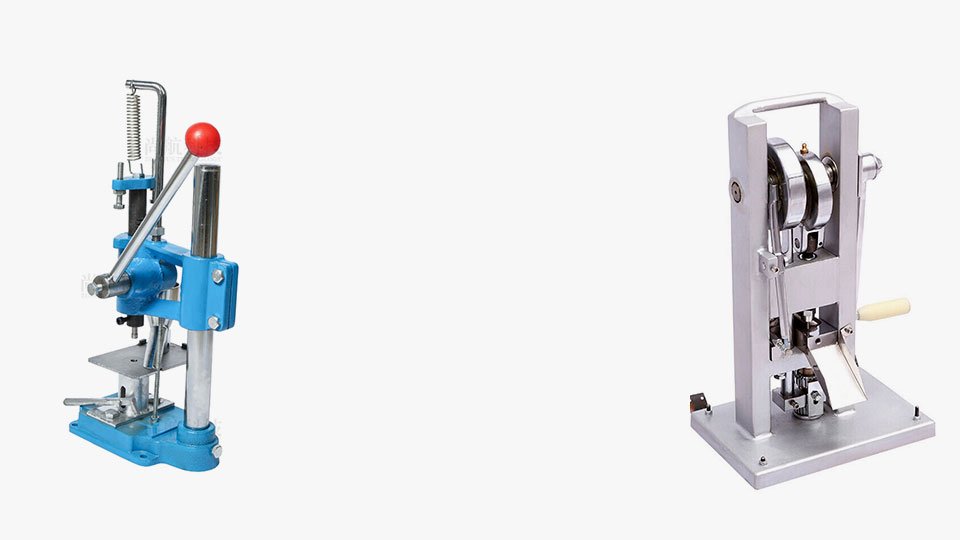
เนื่องจากกระบวนการทั้งหมดต้องอาศัยการทำงานด้วยมือ ประสิทธิภาพจึงต่ำมากอย่างเห็นได้ชัด ผลผลิตที่ได้มีเพียงไม่กี่ร้อยเม็ดต่อชั่วโมง แรงที่ใช้กับวัสดุมีน้อยมาก ทำให้ปริมาณวัสดุที่สามารถบีบอัดได้มีจำกัด เส้นผ่านศูนย์กลางและความหนาสูงสุดของเม็ดยาสามารถสูงสุดได้เพียง 10 มม. และ 6 มม. ตามลำดับ
ข้อดีคือมีต้นทุนต่ำมาก ใช้งานง่ายโดยไม่ต้องมีประสบการณ์มาก่อน และสามารถผลิตแท็บเล็ตได้ทุกที่ทุกเวลา
แท่นอัดยาเม็ดแบบมือใช้กันอย่างแพร่หลายในสถานการณ์ที่ไม่ต้องการยาเม็ดคุณภาพสูงและปริมาณมาก และยังใช้ในงานผลิตขนาดเล็กในโรงงานที่บ้านซึ่งโดยปกติแล้วมีงบประมาณจำกัดอีกด้วย
แท่นอัดเม็ดแบบ Single-Punch หรือที่รู้จักกันในชื่อแท่นอัดเม็ดแบบ Single-Station Cam สามารถผลิตเม็ดยาได้ครั้งละหนึ่งเม็ดเท่านั้น โครงสร้างหลักประกอบด้วยโครง รางนำ ลูกเบี้ยว แท่นอัดบนและล่าง แม่พิมพ์ขึ้นรูป ตัวขูด และถังบรรจุ
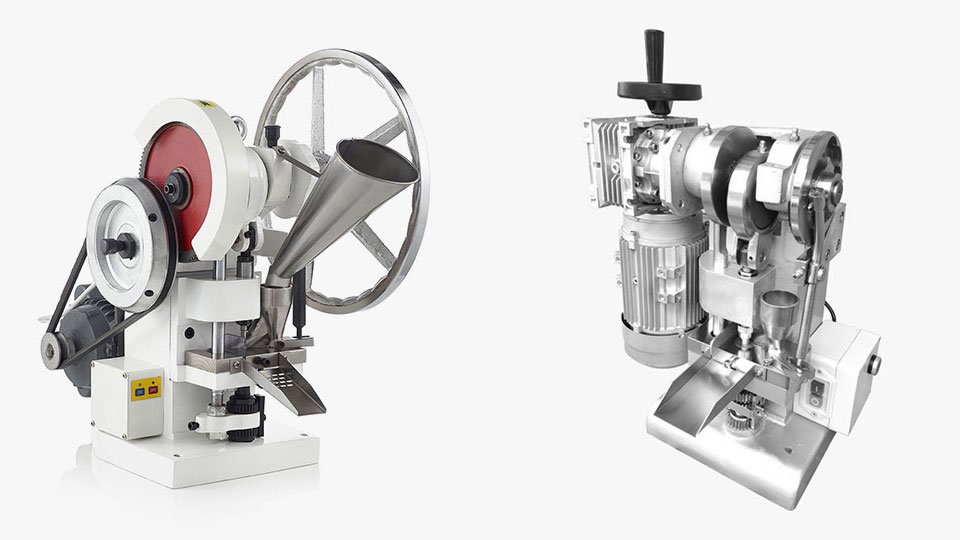
เมื่อเครื่องจักรทำงาน วัสดุจะถูกบรรจุลงในแม่พิมพ์ก่อน จากนั้น ลูกสูบด้านบนและด้านล่างจะเคลื่อนที่ขึ้นลงด้วยแรงขับเคลื่อนของลูกเบี้ยว เพื่ออัดวัสดุในแม่พิมพ์ให้เป็นเม็ดยาตามรูปร่างของแม่พิมพ์ สุดท้าย เครื่องขูดจะกวาดเม็ดยาที่ขึ้นรูปแล้วออกไปในแนวนอน เสร็จสิ้นการกดเม็ดยาหนึ่งรอบ
เนื่องจากเป็นเครื่องอัดเม็ดยาที่ค่อนข้างพื้นฐาน เครื่องอัดเม็ดยาแบบ Single Punch จึงสามารถผลิตเม็ดยาได้เพียงครั้งละหนึ่งเม็ด ส่งผลให้ประสิทธิภาพการผลิตค่อนข้างต่ำ ความแม่นยำในการควบคุมน้ำหนักและความแข็งของเม็ดยายังไม่สูงมากนัก
เมื่อเทียบกับเครื่องอัดเม็ดยาแบบใช้มือแล้ว เครื่องอัดเม็ดยานี้มีประสิทธิภาพการผลิตที่ดีขึ้นอย่างเห็นได้ชัด โครงสร้างที่เรียบง่ายและขนาดพื้นที่ที่เล็กทำให้มีข้อดีหลายประการ เช่น ต้นทุนการจัดซื้อต่ำ ใช้งานง่าย และการบำรุงรักษาและทำความสะอาดที่สะดวก
แท่นอัดยาแบบ Single Punch มักใช้ในการผลิตขนาดเล็ก ห้องปฏิบัติการขนาดเล็ก และงานวิจัยทางวิชาการในโรงเรียน นอกจากนี้ยังใช้ในการผลิตยา โดยเฉพาะอย่างยิ่งในภูมิภาคที่พัฒนาน้อยกว่าของแอฟริกาและพื้นที่ด้อยพัฒนาบางแห่งของเอเชีย ซึ่งยังคงมีส่วนแบ่งตลาดที่สำคัญ
ก. บทนำ
แท่นอัดยาประเภทนี้มีโครงสร้างการส่งผ่านที่คล้ายกับตะกร้า จึงเป็นที่มาของชื่อนี้ โดยทั่วไปมักใช้สำหรับอัดยาเม็ดขนาดใหญ่ เช่น ยาเม็ดผงซักฟอก ยาเม็ดเครื่องล้างจาน และก้อนเหยื่อปลา
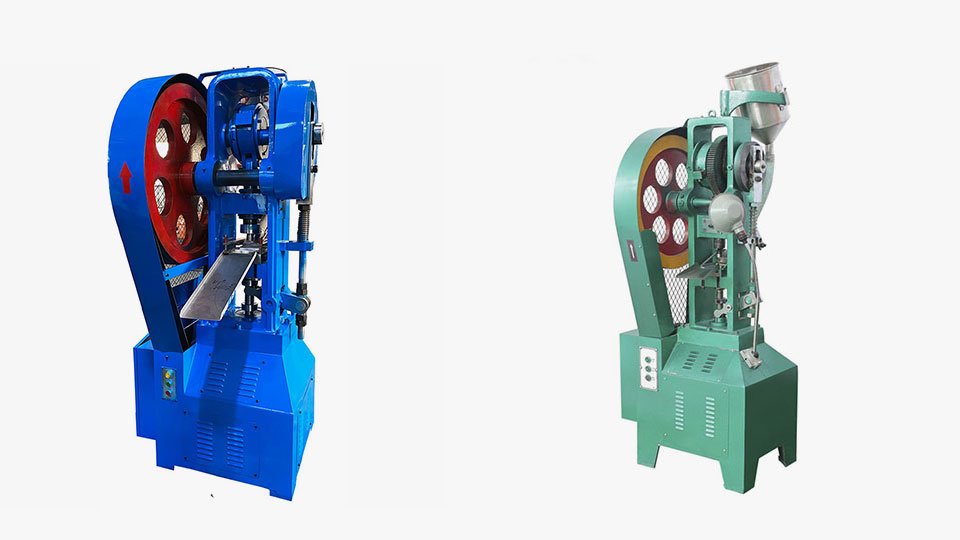
มีสถานีอัดเม็ดยาเพียงแห่งเดียว แม้ว่าจะสามารถปรับแต่งรูได้หลายรูบนแม่พิมพ์เดียวเพื่อเพิ่มผลผลิต แต่กำลังการผลิตของแท่นอัดเม็ดยาแบบตะกร้ายังคงต่ำ นอกจากนี้ เนื่องจากไม่สามารถแยกวัสดุออกจากสภาพแวดล้อมภายนอกได้ จึงไม่เป็นไปตามมาตรฐานการผลิต GMP
ข้อได้เปรียบอยู่ที่ความสามารถในการสร้างแรงอัดสูงผ่านการเคลื่อนที่ในแนวตั้งของชุดหัวปั๊มด้านบนและด้านล่างที่ขับเคลื่อนด้วยมอเตอร์ ซึ่งช่วยให้สามารถขึ้นรูปเม็ดยาขนาดใหญ่ได้
ด้วยความก้าวหน้าทางเทคโนโลยีและความเข้มงวดของมาตรฐานการผลิตทั่วโลก ทำให้เครื่องอัดเม็ดแบบนี้ไม่เหมาะสำหรับใช้ในอุตสาหกรรมยาอีกต่อไป ซึ่งเป็นอุตสาหกรรมที่มีความต้องการยาเม็ดสูงที่สุด เนื่องจากเครื่องอัดเม็ดแบบตะกร้าไม่เป็นไปตามข้อกำหนดการผลิต GMP จึงมักใช้ในอุตสาหกรรมเคมีและอุตสาหกรรมสินค้าอุปโภคบริโภคในชีวิตประจำวันเพื่อผลิตยาเม็ดที่ไม่เหมาะสำหรับการบริโภคของมนุษย์
แท่นอัดยาแบบหมุนเป็นเครื่องอัดยาที่นิยมใช้กันมากที่สุดในปัจจุบัน โครงสร้างหลักประกอบด้วยแท่นหมุน แม่พิมพ์หลายชุด โครงสร้างส่งกำลัง และระบบควบคุม
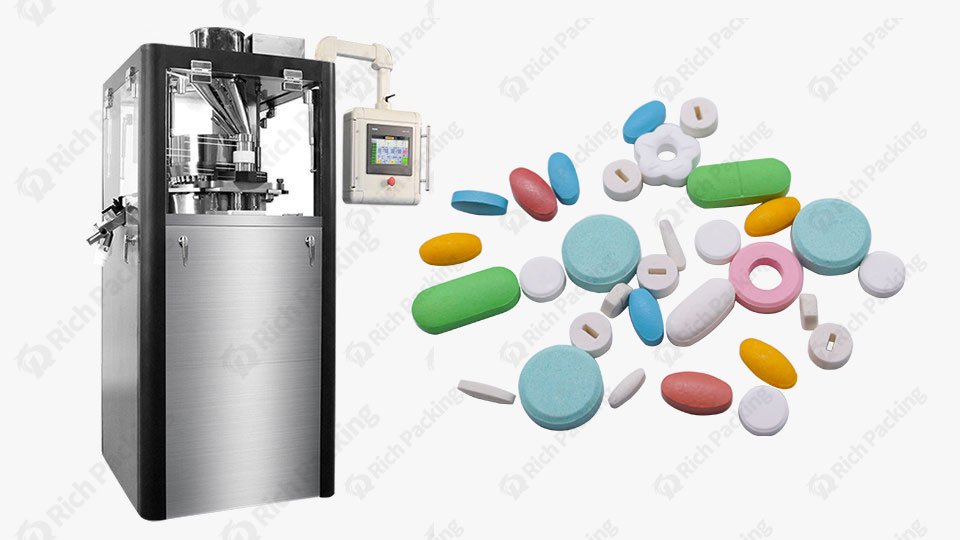
สถานีหลักในกระบวนการอัดยาเม็ดแบบหมุน ได้แก่ สถานีบรรจุ สถานีอัดเบื้องต้น สถานีอัดหลัก และสถานีอัดฉีด ระหว่างการทำงาน แม่พิมพ์หลายชุดจะหมุนไปพร้อมกับแท่นหมุน ขณะที่หัวปั๊มด้านบนและด้านล่างจะเคลื่อนที่ในแนวนอนบนรางนำ
ที่สถานีบรรจุ วัสดุจากตัวป้อนจะตกลงไปในช่องว่างที่เกิดจากการเคลื่อนที่ลงของหัวปั๊มล่าง ส่งผลให้กระบวนการบรรจุเสร็จสมบูรณ์ ปริมาณวัสดุที่เติมขึ้นอยู่กับช่องว่างที่หัวปั๊มล่างเหลืออยู่ในแม่พิมพ์ หลังจากออกจากสถานีบรรจุแล้ว เครื่องขูดจะกำจัดผงส่วนเกินออกจากพื้นผิวด้านบนของแม่พิมพ์ จากนั้นจึงเข้าสู่ช่องทางนำผงกลับคืนสู่ตัวป้อน
ที่สถานีอัดล่วงหน้า ลูกกลิ้งอัดล่วงหน้าจะทำการบีบอัดครั้งแรกเพื่อไล่อากาศออกจากผงในแม่พิมพ์ ประสิทธิภาพของการบีบอัดล่วงหน้าขึ้นอยู่กับระยะเวลาสัมผัสระหว่างหัวปั๊มด้านบนและลูกกลิ้งอัดล่วงหน้า
วัสดุในแม่พิมพ์จะถูกอัดอย่างแรงโดยปั๊มด้านบนและด้านล่างที่สถานีอัดหลัก ทำให้เกิดเป็นแท็บเล็ต
หมัดด้านบนและด้านล่างจะเคลื่อนขึ้นไปตามรางนำการดีดออก โดยยกแท็บเล็ตที่ขึ้นรูปขึ้นเหนือพื้นผิวด้านบนของแม่พิมพ์ และในที่สุดแท็บเล็ตก็จะถูกดีดออกตามราง
1. ผลผลิตสูง:
แท่นพิมพ์ยาเม็ดแบบหมุนทำงานในลักษณะที่ทำให้ประสิทธิภาพการผลิตสูงกว่าแท่นพิมพ์ประเภทอื่นๆ มาก ประสิทธิภาพการผลิตสามารถเพิ่มขึ้นได้อีกโดยการเพิ่มแม่พิมพ์บนแท่นหมุนและเพิ่มความเร็วในการหมุนของแท่นหมุน
นอกจากกำลังผลิตสูงแล้ว แท่นอัดยาแบบหมุนยังสามารถติดตั้งฟังก์ชันเพิ่มเติมผ่านการเขียนโปรแกรมระบบอัจฉริยะ PLC ได้อย่างมีประสิทธิภาพ มอบประสิทธิภาพการทำงานที่ชาญฉลาด สะดวกสบาย และใช้งานได้จริง การตั้งค่าพารามิเตอร์บนอินเทอร์เฟซ HMI โดยไม่ต้องปรับแต่งโครงสร้างเครื่องที่ซับซ้อน ช่วยให้สามารถปรับความหนา ความแข็ง และพารามิเตอร์อื่นๆ ของเม็ดยาได้อย่างง่ายดาย
แท่นพิมพ์ยาเม็ดแบบหมุนที่ทันสมัยมีอินเทอร์เฟซข้อมูลหลากหลาย ช่วยให้สามารถส่งข้อมูลผ่านพอร์ตอีเทอร์เน็ต Type-C และ USB รองรับการอัปโหลดและดาวน์โหลดข้อมูล นับเป็นรากฐานที่แข็งแกร่งสำหรับบริษัทยาและอุตสาหกรรมอื่นๆ ในการยกระดับสู่มาตรฐานอุตสาหกรรม 4.0
แท่นอัดยาเม็ดแบบหมุนเป็นรุ่นที่มีความอเนกประสงค์มากที่สุด สามารถผลิตยาเม็ดได้หลากหลายประเภท ตั้งแต่เส้นผ่านศูนย์กลาง 2 มม. ถึง 100 มม. ความหนา 1 มม. ถึง 60 มม. และรูปทรงต่างๆ ตั้งแต่มาตรฐานไปจนถึงรูปทรงไม่สม่ำเสมอ รวมถึงยาเม็ดแบบชั้นเดียวและหลายชั้น เหมาะอย่างยิ่งสำหรับการผลิตยา อาหาร อาหารเสริม และอุตสาหกรรมเคมี
แม่พิมพ์ของเครื่องอัดเม็ดยาเป็นตัวกำหนดขนาดและรูปร่างของเม็ดยาที่ผลิต เครื่องอัดเม็ดยามีความหลากหลายและสามารถผลิตเม็ดยาได้หลากหลายรูปแบบ เพียงแค่เปลี่ยนแม่พิมพ์ ซึ่งอาจเป็นทรงกลม วงรี รูปเพชร รูปวงแหวน ฯลฯ
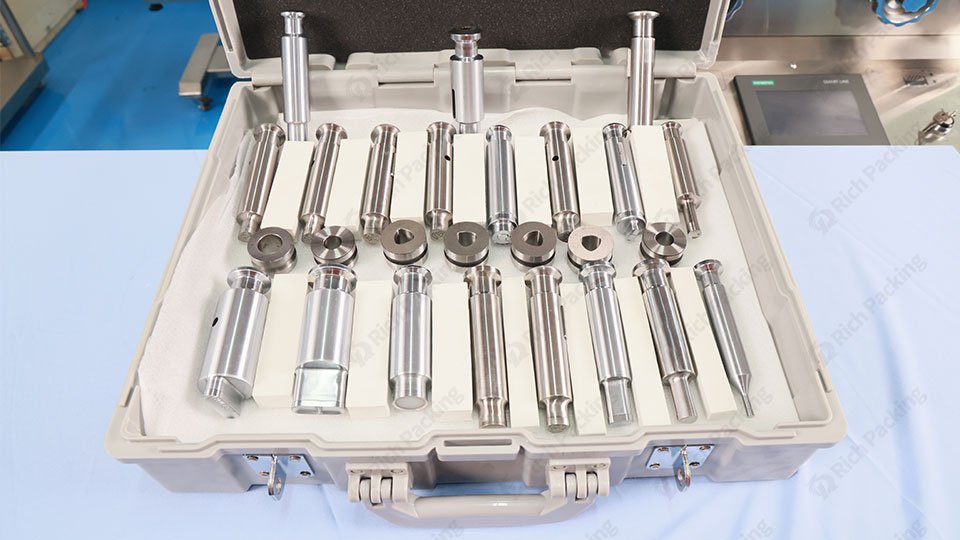
หัวปั๊มด้านบนจะเคลื่อนลงระหว่างกระบวนการอัดเม็ดยา โดยจะอัดวัสดุด้วยหัวปั๊มด้านล่างที่สถานีอัดหลัก หัวปั๊มด้านบนมีหมุดสำหรับยึดตำแหน่ง เพื่อให้แน่ใจว่าหัวปั๊มด้านบนและด้านล่างจะอยู่ในทิศทางเดียวกันตลอดระยะเวลาการทำงานที่ยาวนาน
หัวปั๊มล่างจะเคลื่อนขึ้นไปตามรางนำระหว่างการบีบอัด โดยกดวัสดุด้วยหัวปั๊มบนที่สถานีการบีบอัด จากนั้นจึงเคลื่อนขึ้นที่สถานีการอัดเพื่อดันแท็บเล็ตออกจากแม่พิมพ์
แม่พิมพ์คือส่วนที่บรรจุและบีบอัดวัสดุ แม่พิมพ์ต้องทนต่อแรงขยายตัวในแนวนอนที่เกิดขึ้นระหว่างการบีบอัด
การเลือกวัสดุสำหรับแม่พิมพ์ต้องพิจารณามาตรฐานหลายประการ:
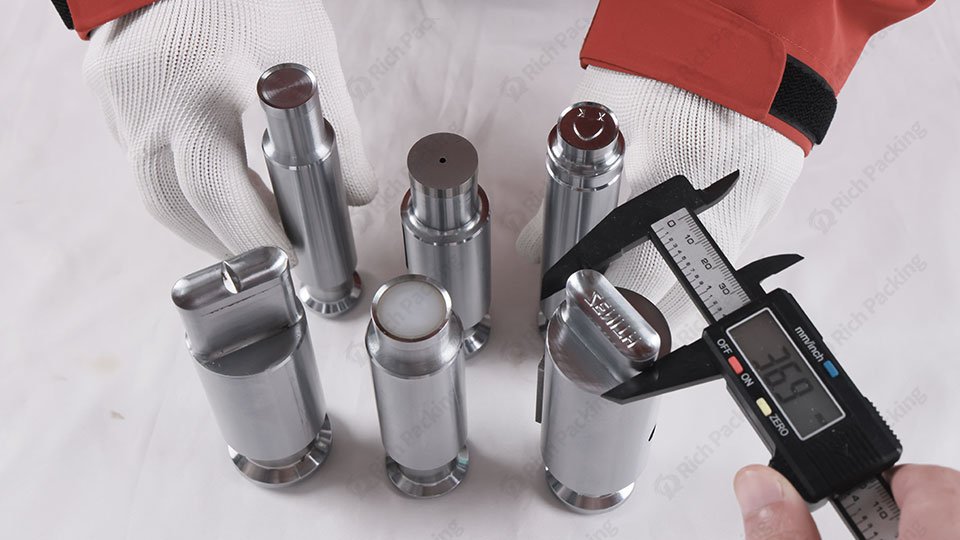
วัตถุดิบบางชนิดอาจมีสารเคมีกัดกร่อน หากแม่พิมพ์ไม่ทนต่อการกัดกร่อน แม่พิมพ์อาจทำปฏิกิริยาทางเคมีกับวัสดุ ทำให้เกิดการปนเปื้อนของเม็ดยาและลดอายุการใช้งานของแม่พิมพ์
แม่พิมพ์ต้องถูกอัดด้วยแรงดันสูงเป็นเวลานาน ความแข็งที่ไม่เพียงพออาจทำให้เกิดการเสียรูป ส่งผลกระทบต่อขนาดและรูปร่างของเม็ดยา
ปริมาณโลหะในการผลิตยาต้องเป็นไปตามมาตรฐานที่เข้มงวด แม่พิมพ์ต้องทนทานต่อการสึกหรอสูง เนื่องจากการสึกหรอมากเกินไปอาจทำให้เกิดอนุภาคโลหะปนเปื้อนในเม็ดยา ซึ่งส่งผลกระทบอย่างรุนแรงต่อคุณภาพของผลิตภัณฑ์
วัสดุของแม่พิมพ์ต้องไม่มีส่วนประกอบที่เป็นอันตรายใดๆ เนื่องจากต้องสัมผัสกับวัสดุโดยตรง แม้แต่อนุภาคโลหะขนาดเล็กที่ปะปนกับเม็ดแม่พิมพ์ก็ไม่ควรเป็นอันตรายต่อสุขภาพของมนุษย์
ดังนั้นแม่พิมพ์ของเครื่องอัดเม็ดยาจึงมักทำจากสแตนเลสหรือโลหะผสมแข็ง เนื่องจากมีความทนทานต่อการกัดกร่อนดีเยี่ยม มีความแข็งสูง ทนต่อการสึกหรอ และไม่มีพิษ
หลังจากพิจารณาการจำแนกประเภทของเครื่องอัดเม็ดยาข้างต้นแล้ว คุณน่าจะเข้าใจพื้นฐานแล้ว อย่างไรก็ตาม เมื่อถึงเวลาต้องซื้อเครื่องจริงๆ ต่อไปนี้คือคำแนะนำที่ชัดเจนและเป็นมืออาชีพมากขึ้น:
1. ข้อแนะนำในการเลือกประเภท
หากคุณใช้สำหรับการประชุมเชิงปฏิบัติการที่บ้านหรือการผลิตแบบเป็นกลุ่มเล็ก หรือหากความต้องการเส้นผ่านศูนย์กลางแท็บเล็ตของคุณอยู่ที่ประมาณ 10 มม. แท็บเล็ตเพรสแบบใช้มือหรือเครื่องเพรสแบบเจาะเดี่ยวจะเหมาะกับคุณ
หากคุณอยู่ในอุตสาหกรรมเคมีหรืออุตสาหกรรมเครื่องใช้ในครัวเรือนและจำเป็นต้องกดเม็ดยาที่มีเส้นผ่านศูนย์กลางใหญ่และหนา (เช่น แท่งถ่าน แท่งเหยื่อ) และคุณไม่ต้องการปริมาณการผลิตสูง เครื่องกดเม็ดยาแบบตะกร้าจึงเป็นตัวเลือกที่ดี
หากคุณอยู่ในสถานการณ์ต่อไปนี้: บริษัทยาขนาดกลางถึงขนาดใหญ่ ผู้ผลิตผลิตภัณฑ์เพื่อสุขภาพ ในประเทศหรือภูมิภาคที่มีมาตรฐาน GMP ที่เข้มงวด มีข้อกำหนดการผลิตสูงสำหรับการอัดยาเม็ด และต้องการยาเม็ดคุณภาพสูง (น้ำหนักสม่ำเสมอ ความแข็งสูง พื้นผิวเรียบ) เราขอแนะนำอย่างยิ่งให้ซื้อเครื่องอัดยาเม็ดแบบหมุน ซึ่งเป็นรุ่นที่ใช้งานได้หลากหลายกว่า นี่คือตัวเลือกที่เหมาะสมที่สุดสำหรับคุณ
สำหรับเม็ดยาที่มีเส้นผ่านศูนย์กลางสูงสุด 25 มม. เราขอแนะนำให้เลือกเครื่องอัดเม็ดยาแบบหมุนรุ่น ZP-29D
สำหรับเส้นผ่านศูนย์กลางเม็ดยาระหว่าง 25 มม. ถึง 60 มม. เราขอแนะนำให้เลือกเครื่องอัดเม็ดยาขนาดใหญ่ ZP-15/19E
หากคุณมีข้อกำหนดที่เข้มงวดเกี่ยวกับน้ำหนักและความหนาของแท็บเล็ต เราขอแนะนำให้เลือกเครื่องอัดแท็บเล็ตความเร็วสูง HZP-26/40
เลือกเครื่องจักรให้เหมาะสมกับปริมาณการผลิตที่คุณคาดหวัง ความเร็วจะส่งผลต่อประสิทธิภาพการผลิตโดยรวม
กำหนดแรงอัดที่ต้องการโดยอิงจากคุณลักษณะวัตถุดิบและข้อกำหนดของแท็บเล็ตของคุณ
ระบบควบคุมอัจฉริยะสามารถตอบสนองความต้องการการผลิตของคุณ เช่น การเขียนโปรแกรม PLC การบันทึกข้อมูล ฯลฯ ได้หรือไม่
พิจารณาความง่ายในการเปลี่ยนแม่พิมพ์และต้นทุนการบำรุงรักษาซึ่งส่งผลต่อความยืดหยุ่นในการผลิตและการควบคุมต้นทุน
ด้วยคำแนะนำและพารามิเตอร์โดยละเอียดเหล่านี้ คุณสามารถเลือกเครื่องอัดเม็ดยาที่เหมาะกับความต้องการการผลิตจริงและงบประมาณของคุณได้ดีขึ้น ช่วยให้มั่นใจถึงประสิทธิภาพการผลิตและคุณภาพของผลิตภัณฑ์สูง พร้อมทั้งเพิ่มผลตอบแทนจากการลงทุนให้สูงสุด
|
แบบอย่าง |
แซดพี-20 |
แซดพี-27ดี |
แซดพี-29ดี |
แซดพี-25/55ดี |
แซดพี-41/55 |
แซดพี-26/50ดี |
แซดพี-51/99ดี |
|
เอาท์พุต ชิ้น/ชม. |
40,000 |
90,000 |
110,000 |
160,000 |
266,000 |
330,000 |
950,000 |
|
แรงกดต่อย |
80KN |
120KN |
100KN |
100KN |
120KN,ก่อน:20KN |
150KN,ก่อน:16KN |
150KN,ก่อน:150KN |
|
เส้นผ่านศูนย์กลางสูงสุด |
25 มม. |
25 มม. |
24 มม. |
25 มม. |
25 มม. |
25 มม. |
25 มม. |
|
ความหนาสูงสุด |
8 มม. |
25 มม. |
12 มม. |
15มม. |
9 มม. |
8 มม. |
8 มม. |
|
ขนาด(มม.) |
840*1015*1720 |
1040*910*1690 |
1040*910*1690 |
1240*850*1850 |
1220*1120*1980 |
820*1100*1750 |
1310*1305*2010 |
|
น้ำหนัก(กก.) |
1,200 |
1,600 |
1,600 |
1,850 |
2,100 |
1,660 |
5,510 |
|
พลังงานรวม |
4.0 กิโลวัตต์ |
7.5 กิโลวัตต์ |
5.5 กิโลวัตต์ |
5.5 กิโลวัตต์ |
7.5 กิโลวัตต์ |
7.5 กิโลวัตต์ |
11.0 กิโลวัตต์ |
เครื่องอัดเม็ดยาและเครื่องบรรจุแคปซูลถือเป็นอุปกรณ์การผลิตที่สำคัญในอุตสาหกรรมยา โดยมีหลักการทำงาน รูปแบบยา ความเร็วในการผลิต และคุณลักษณะของผลิตภัณฑ์ขั้นสุดท้ายที่แตกต่างกัน
เอ เครื่องอัดเม็ดยา อัดผง เม็ดเล็ก เม็ดเล็กจิ๋ว ฯลฯ ภายใต้แรงดันเพื่อสร้างเม็ดยาที่เป็นของแข็ง
เครื่องบรรจุแคปซูลจะบรรจุแคปซูลเปลือกแข็งหรือแคปซูลเจลาตินอ่อนด้วยวัสดุแข็ง เช่น ผง เม็ดเล็ก ไมโครแกรนูล หรือสารแขวนลอย น้ำมัน ฯลฯ
เครื่องทำยาเม็ดผลิตยาเม็ดแข็งในรูปแบบต่างๆ รวมถึงยาเม็ดปกติ ยาเม็ดเคลือบเอนเทอริก และยาเม็ดออกฤทธิ์ช้า
เครื่องบรรจุแคปซูลจะผลิตสูตรยาในรูปแบบแคปซูล โดยบรรจุด้วยเม็ดแข็ง ผง เม็ดเล็ก หรือยาของเหลวในกรณีของแคปซูลนิ่ม
3. ความเร็วในการผลิต
สำหรับการผลิตยาขนาดใหญ่ โดยเฉพาะเครื่องอัดยาเม็ดแบบโรตารี จะให้ความเร็วและประสิทธิภาพในการผลิตที่สูงกว่าเมื่อเทียบกับเครื่องบรรจุแคปซูล เครื่องอัดยาเม็ดแบบโรตารีสามารถเพิ่มผลผลิตได้โดยการประกอบแม่พิมพ์จำนวนมากขึ้นบนแท่นโรตารีเดียวกัน ในโรงงานผลิตยาขนาดใหญ่ สามารถผลิตยาเม็ดที่มีเส้นผ่านศูนย์กลางตั้งแต่ 6 มม. ถึง 12 มม. ได้ด้วยจังหวะเดียวของเครื่องนี้บนแม่พิมพ์หลายชุด
โดยทั่วไป เครื่องบรรจุแคปซูลจะทำงานด้วยความเร็วที่ช้ากว่าเมื่อเทียบกับเครื่องอัดเม็ดยา ผลผลิตของเครื่องบรรจุแคปซูลขึ้นอยู่กับสถานีบรรจุหลายสถานี โดยทั่วไปเครื่องอัดแคปซูลจะมีสถานีบรรจุ 1 ถึง 3 สถานี และมีรูแคปซูลมากถึง 3 แถว ทำให้ผลผลิตมีจำกัด การบรรจุแคปซูลเป็นแบบเป็นช่วงๆ ซึ่งแตกต่างจากเครื่องอัดเม็ดยาที่ทำงานต่อเนื่อง แม้ว่าอุปกรณ์อัตโนมัติสมัยใหม่จะสามารถบรรจุแคปซูลด้วยความเร็วสูงได้ เหมาะสำหรับธุรกิจขนาดกลางถึงขนาดใหญ่
แท่นอัดยาเม็ดให้ผลผลิตที่คุ้มค่าและควบคุมปริมาณยาได้อย่างแม่นยำ อย่างไรก็ตาม แท่นอัดยาเม็ดอาจมีข้อจำกัดสำหรับ